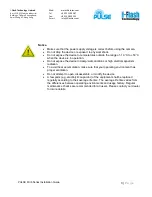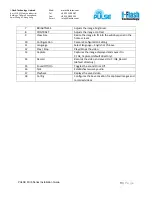
i-Flash Technology Limited
Rm 1110, 11F, Fabrico Industrial
Buildings, 78 Kwai Cheung Road,
Kwai Chung, NT. Hong Kong
Web:
Tel:
Fax:
Email:
www.iflashtec.com
+852 2110 9587
+852 3585 5233
[email protected]
PULSE FXI6 Series Installation Guide
16 |
P a g e
Video Settings
Preferred Video Codec
– The
FXI6
supports the H.264 video codec.
Resolution
– The higher the resolution is, the better the video quality is, and higher
bandwidth is required.
Bit Rate
– The number of bits that are conveyed or processed per unit of time.
Maximum Frame Rate
– The video frame rate is adjustable based on network conditions.
Increasing the frame rate will increase the amount of data significantly
therefore consuming more bandwidth. Video will be impaired due to packet
loss when there is insufficient bandwidth.
Bit Rate Control
– Variable Bit rate (VBR) and Constant Bit Rate (CBR).
Variable Bit Rate - If VBR is selected, the codec varies the amount of output
data per time segment. VBR produces a better quality-to-space ratio. The
bits available are used to enable more flexibly and encode sound or video
data more accurately, with fewer bits used in less demanding passages and
more bits used in difficult-to-encode passages.
Constant Bit Rate - If CBR is selected, the codec’s output data is constant
regardless of the input data. The output bit rate is defined in “Bit rate”. CBR
is useful for streaming multimedia content on limited capacity channels. It is
easier to calculate required bandwidth as well as the required storage space
using CBR.
Image Quality
If ‘Bit Rate Control’ is set to “VBR”, “Image quality” needs to be configured.
The better the video quality is, the higher the bit rate will be.
I-frame Interval
– While streaming video over a network, compression technologies are used
to show the incremental difference between each frame. I-frames are used
to help keep the video looking normal. When intervals are shorter, the
video quality is higher but uses more bandwidth.
















































